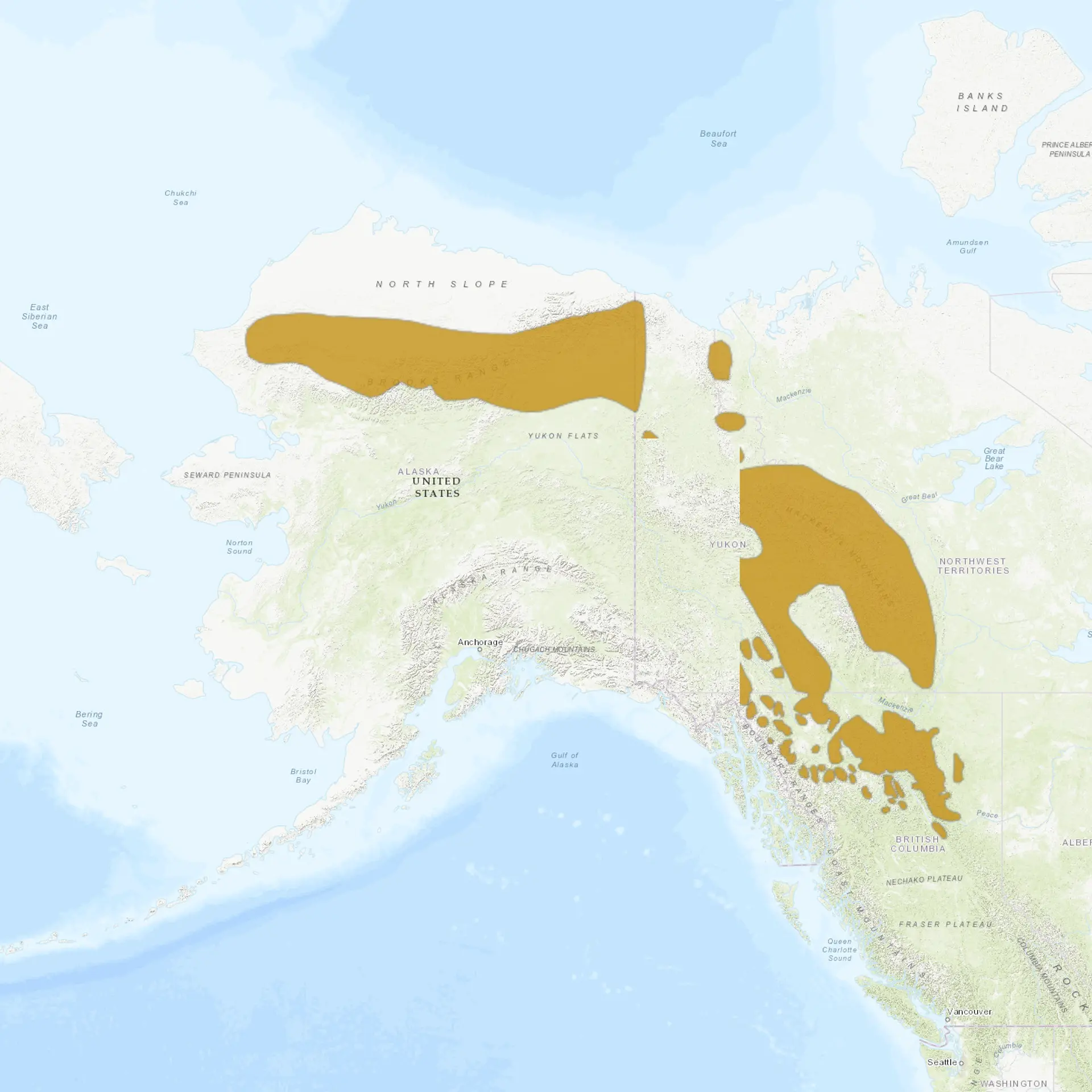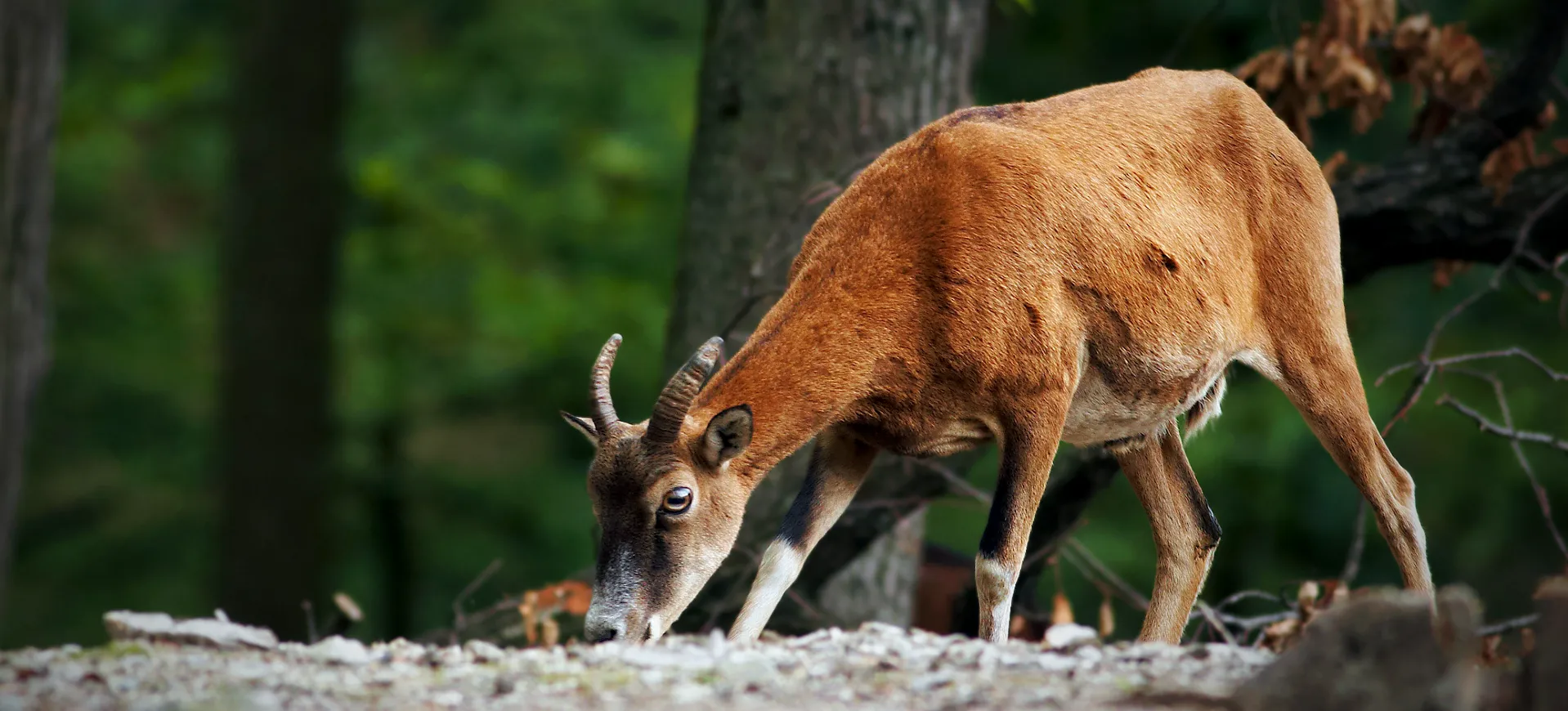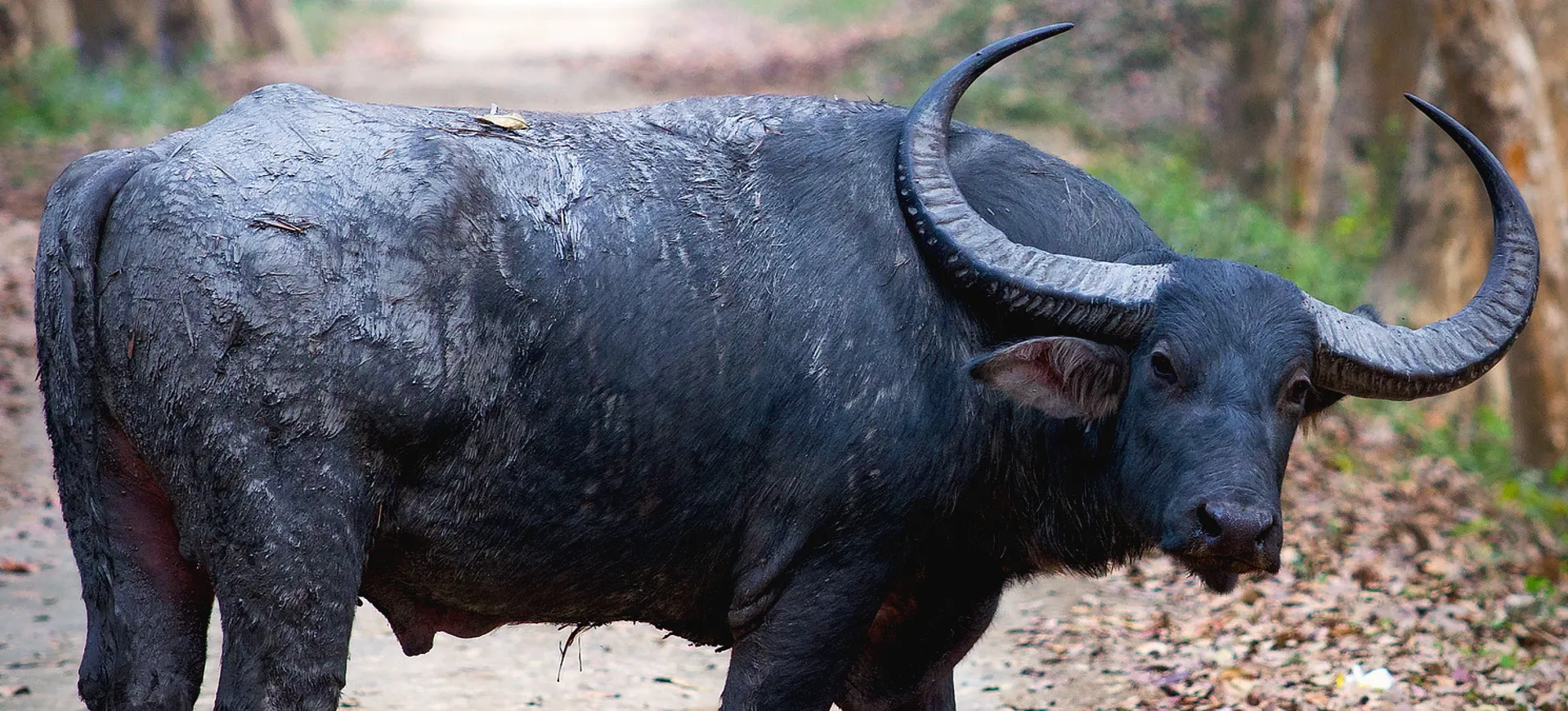Overview
Dall Sheep (Ovis dalli) are a wild sheep species native to the mountainous regions of northwestern North America, particularly Alaska, the Yukon, and parts of British Columbia. They are known for their striking white or light-colored coats, which serve as camouflage in snowy environments. Dall Sheep inhabit steep, rocky alpine terrain, which provides protection from predators and offers access to sparse vegetation. These highly social sheep typically live in separate male and female groups outside the breeding season, with rams growing large and curled horns used in dominance battles during mating.
The horns of male Dall Sheep, known as rams, are a defining feature, with mature males growing massive, spiral horns that can weigh up to 40 lbs (18 kg). Females, or ewes, have much smaller and less curved horns. Dall Sheep are herbivores, primarily feeding on grasses, sedges, and other alpine vegetation in the summer and shifting to mosses and lichens in the winter. Their populations are generally stable, although they face threats from habitat encroachment, climate change, and disease transmission from domestic livestock.
Dall Sheep are well-adapted to life in harsh environments. Their compact bodies and specialized hooves allow them to traverse steep cliffs and rocky outcrops. These adaptations help them avoid predators such as wolves, bears, and golden eagles. The species plays a key ecological role in alpine ecosystems, helping to maintain plant diversity through selective grazing. Despite their current conservation status of Least Concern, careful monitoring of their populations is essential to ensure they remain resilient to environmental changes and human impact.
Taxonomy
Kingdom
Phylum
Class
Order
Family
Genus
Species
Type
Current distribution:
Dall Sheep are distributed across northwestern North America, with their largest populations found in Alaska and the Yukon Territory. In Alaska, they are particularly abundant in the Alaska Range, the Wrangell Mountains, and the Chugach Range, where they inhabit remote, mountainous areas. In the Yukon, they are found in the Ogilvie and Saint Elias Mountains, with smaller populations extending into northern British Columbia. Their range is generally restricted to high-altitude alpine and subalpine environments, where they are well adapted to harsh conditions.
Although their overall population is stable, Dall Sheep are found in fragmented pockets, particularly in areas where their habitat has been impacted by human activities such as mining or road development. They also exist in several national parks and protected areas, where conservation efforts help maintain their populations. These sheep are generally considered widespread within their range, but localized declines can occur due to environmental pressures or disease. Conservation efforts focus on habitat protection and monitoring population trends to ensure their continued survival.
Physical Description:
Dall Sheep are medium-sized wild sheep with males (rams) typically weighing between 160-250 lbs (73-113 kg) and females (ewes) weighing 100-150 lbs (45-68 kg). They have a white or light beige coat that helps them blend into their snowy alpine habitats, providing camouflage from predators. Rams are most notable for their large, curled horns, which can reach lengths of 40 inches (102 cm) and are used in head-to-head combat with other males during the mating season. Ewes have much smaller, slender horns that are slightly curved and typically reach 6-12 inches (15-30 cm) in length.
Both rams and ewes have muscular, stocky bodies well-suited for life in rugged, mountainous terrain. Their legs are short and strong, allowing them to easily navigate cliffs and rocky outcrops. Dall Sheep have specialized hooves with a hard outer edge and a soft inner pad, providing excellent grip on rocky surfaces. Their dense fur helps insulate them against the cold temperatures of their high-altitude habitats, particularly in winter when their coat become thicker.

Lifespan: Wild: ~16 Years || Captivity: ~20 Years

Weight: Male: 160-250 lbs (73-113 kg) || Female: 100-150 lbs (45-68 kg)

Length: Male: 50-60 in (127-152 cm) || Female: 45-55 in (114-140 cm)

Height: Male: 35-40 in (89-102 cm) || Female: 30-35 in (76-89 cm)

Top Speed: 30 mph (48 km/h)
Characteristic:
Native Habitat:
Dall Sheep are native to the rugged mountainous regions of northwestern North America, with their range primarily encompassing Alaska, the Yukon, and northern British Columbia. They are typically found in alpine and subalpine environments, inhabiting steep, rocky slopes and cliffs between 3,000 and 6,000 feet (900 to 1,800 meters). These habitats protect them from predators and access to the sparse vegetation they rely on for food. Dall Sheep prefer grassy meadows for grazing and rocky outcrops for safety and shelter.
In the summer, dall sheep often move to higher elevations to take advantage of the fresh grasses and plants that grow in alpine meadows. During the winter, they descend to lower elevations or south-facing slopes where the snow cover is thinner, allowing them to forage for food more easily. Their habitats are often remote and difficult to access, which helps protect them from human disturbance. However, these areas are increasingly impacted by climate change and human activities, such as mining and road construction, which can fragment their range.
Climate Zones:
Biomes:
WWF Biomes:
Biogeographical Realms:
Continents:
Countries:
Diet:
Diet & Feeding Habits:
Dall Sheep are herbivores, consisting primarily of grasses, sedges, and flowering plants during the summer when these food sources are abundant. As the seasons change and food becomes scarce, they shift their diet to include lichens, mosses, and dried grasses that they dig out from beneath the snow. Their ability to survive in such harsh environments is partly due to their selective feeding habits, as they choose the most nutrient-rich plants to maintain their health. During the winter, their grazing often occurs on windswept ridges and south-facing slopes where snow cover is less deep, allowing for easier access to food.
Dall Sheep also rely on mineral licks to supplement their diet with essential nutrients, particularly salt, which is scarce in their regular food sources. These salt licks are vital for maintaining their health and are often visited regularly by entire herds. In areas where water is scarce, Dall Sheep obtain much hydration from the moisture content in the vegetation they consume. Their digestive system is specialized for breaking down fibrous plant material, with their multi-chambered stomachs allowing them to efficiently extract nutrients from tough, alpine plants.
Mating Behavior:
Mating Description:
Dall Sheep follow a polygynous mating system, with dominant males, known as rams, competing to mate with multiple females, or ewes, during the breeding season. The rutting season occurs in late November and December, during which rams engage in head-to-head combat, using their massive, curled horns to establish dominance. These dramatic battles, where rams charge at each other and clash their horns together, can last for hours, with the winner gaining the right to mate. Once a male has won, he will mate with several females within his territory.
Gestation lasts around 170 days, and ewes give birth to a single lamb, typically in late May or early June. Lambs are highly precocial, able to stand and walk within hours of birth, though they remain closely dependent on their mothers for the first few months. Dall Sheep are viviparous, giving birth to live young, and lambs are weaned by the time they are 3-5 months old. Ewes typically find secluded mountain areas to give birth, where the terrain protects them from predators.
Reproduction Season:
Birth Type:
Pregnancy Duration:
Female Name:
Male Name:
Baby Name:
Social Structure Description:
Dall Sheep exhibits a distinct social structure, with males and females living in separate groups for most of the year. Rams typically form small bachelor groups, while ewes live in larger herds with their lambs, protecting from predators. During the rutting season, rams leave their bachelor groups and compete for dominance in head-butting contests to gain access to ewes. After the mating season, males and females separate again, with rams returning to their bachelor groups and ewes continuing to care for their young.
The herd communicates primarily through body language and vocalizations, with rams using their horns and physical posturing to assert dominance during the breeding season. Ewes form strong social bonds with their lambs, which persist until they are weaned. The herd provides safety in numbers, helping to protect members from predators. Dall Sheep are highly vigilant animals, relying on their keen senses and the collective awareness of the group to detect danger.
Groups:
Conservation Status:
Population Trend:
Dall Sheep populations are considered stable, with an estimated 66,000 individuals distributed across their range in Alaska, the Yukon, and northern British Columbia. They are found primarily in remote, high-altitude regions where human impact is limited, and large portions of their habitat are protected in national parks and wildlife reserves. However, localized populations can be affected by factors such as habitat loss due to mining and road construction and competition with domestic livestock. Disease transmission from domestic sheep and goats is also a concern in areas where their ranges overlap.
In areas where Dall Sheep habitats are disturbed by human activities, population monitoring and conservation measures have been implemented to help mitigate the impact. Hunting is regulated to ensure sustainable population numbers, with certain regions designated protected areas where hunting is prohibited. Despite these conservation efforts, ongoing monitoring is required to ensure that Dall Sheep populations remain resilient to environmental pressures and human encroachment.
Population Threats:
The primary threats to Dall Sheep populations include habitat loss and fragmentation due to human activities, such as mining, road development, and resource extraction. These activities can disrupt migration routes and reduce access to critical feeding areas, particularly in winter. Disease transmission from domestic livestock, such as pneumonia, is another significant threat impacting Dall Sheep populations, especially where wild and domestic sheep ranges overlap. Climate change is an emerging threat, as it alters the alpine environments these sheep depend on for food and shelter.
Natural predators of Dall Sheep include wolves, bears, and golden eagles, with young lambs particularly vulnerable to predation. However, predation is not as significant a threat as human-related factors. Conservation efforts are focused on managing habitat, regulating hunting, and minimizing disease transmission from domestic animals. Public awareness campaigns and collaborations between wildlife managers and industry stakeholders are essential for mitigating the impact of human activities on Dall Sheep populations.
Conservation Efforts:
Conservation efforts for Dall Sheep focus on habitat protection, regulated hunting, and disease management. Wildlife agencies monitor Dall Sheep populations in Alaska, Yukon, and British Columbia to ensure sustainable population levels. Hunting regulations are in place to control harvest levels and ensure that hunting does not negatively impact population numbers. In some areas, particularly national parks and wildlife reserves, hunting is prohibited to provide safe havens for Dall Sheep populations.
Efforts are also being made to minimize the risk of disease transmission from domestic livestock, particularly in regions where domestic sheep and goats are grazed near wild sheep habitats. Wildlife managers work to educate local communities and ranchers on the importance of preventing contact between wild and domestic sheep to reduce the spread of diseases. Ongoing research into Dall Sheep health, population dynamics, and habitat use helps inform management decisions and ensure the long-term conservation of the species.
Additional Resources:
Fun Facts
- Dall Sheep is named after American naturalist William H. Dall.
- Rams can engage in hours-long head-butting contests, with collisions loud enough to be heard from far away.
- Their curled horns continue to grow throughout their lives, developing ridges that indicate their age.
- Dall Sheep can leap up to 20 feet (6 meters) to navigate rocky terrain.
- Their white coats provide excellent camouflage in snowy environments, helping them avoid predators.
- Ewes typically give birth to a single lamb each year, which can walk within hours of being born.
- Dall Sheep are known for their remarkable climbing abilities, often navigating near-vertical cliffs to escape predators.
- Mineral licks are important for their diet, providing essential nutrients like salt.
- Their four-chambered stomach allows them to digest tough, fibrous plants.
- Dall Sheep are sometimes called “Thinhorn Sheep” due to the thinner shape of their horns compared to Bighorn Sheep.

















































































